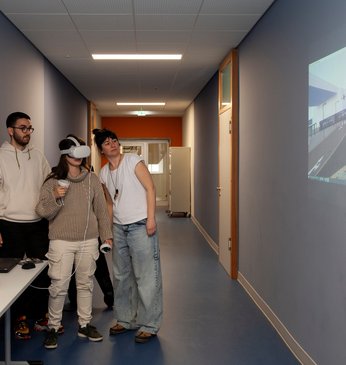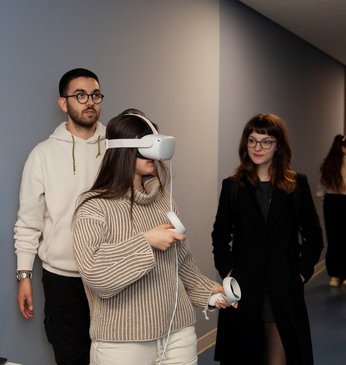- Understand the principles and methodologies of virtual reconstruction in architectural heritage preservation.
- Acquire practical skills in using virtual reality and 3D modelling tools for architectural reconstruction.
- Analyze the ethical and theoretical implications of virtual reconstruction in heritage preservation.
- Apply digital technologies to document, restore, and present architectural heritage sites.
- Collaborate effectively in interdisciplinary teams for virtual reconstruction projects.
- Evaluate the effectiveness and impact of virtual reconstruction in engaging audiences and promoting architectural heritage awareness.
Virtual Reconstruction of Architectural Heritage: Preserving the Past in the Digital Age
Virtual Reconstruction of Architectural Heritage: Preserving the Past in the Digital Age
This course on "Virtual Reconstruction of Architectural Heritage" offers students a unique opportunity to explore the intersection of technology and monumental historic preservation. Through a combination of online lectures, on-site fieldwork, and interactive assignments, students will learn how to digitally reconstruct and preserve architectural heritage using advanced virtual reality and 3D modelling techniques. This immersive learning experience will equip students with the skills and knowledge to contribute to the preservation and interpretation of architectural heritage in the digital age.
The course is divided into three parts led by Pappal Suneja (PS) from Bauhaus Universität Weimar, and Miroslav Malinović (MM) and Maja Ilić (MI) from the University of Banja Luka, Bosnia.
The online part of the course covers knowledge of heritage survey, fieldwork, and analysis methods — including basic information on materials, technologies, and assessment approaches. (MM). The second part of the online course deals with the documentation of architectural heritage as a result of the surveying process, leading to appropriate technical sheets and drawings required for the creation of 3D or virtual models. (PS). Finally, the third part of the online course summarises the methods for creating a 3D model of a building or facility that can be used as the basis for a virtual reality presentation, physical model, or other appropriate presentation techniques. (MI)
Prior to the on-site part of the Spring School, students will be given a template to select an architectural monument from their own cultural landscape and conduct the basic preparatory surveys.
On-site, students will continue to work on the documentation of their selected case studies and possibly learn about other similar cases in Weimar and the surrounding area through field trips. Professional, technical production of sheets, models and digital environment will be supervised in the classroom (PS & MM), while on the last day a suitable presentation technique for a temporary exhibition will be selected.
The intention is to motivate students to seek out valuable architectural heritage in their environment, document it, and present it to participants in order to share knowledge and raise awareness of heritage values and their importance to society. The goal is to equip students with the knowledge they need to further explore the topic of “Virtual Reconstruction of Architectural Heritage” during their studies and later in their professional careers.
NOTE:
This course includes an attendance phase in Weimar from March 14 to March 23, 2024.
The course is suitable for bachelor's/master's students and preferably, but not exclusively, for participants with interest in the fields of building heritage, conservation, monument preservation, architectural design, and project management.
Knowledge of Auto CAD software + any kind of 3d modelling software will be suitable.
Pappal Suneja
ajc-plus.com
1993, Ludhiana, Punjab, India
MSc "Design Research", Bauhaus Dessau
Ph.D. Candidate, Faculty of Architecture and Urbanism, Bauhaus Universität Weimar.
Visiting Researcher & lecturer at: the Canadian Centre of Architecture Montreal, German Historical Institute London, University of TorVergata Rome, University of Brighton and Anhalt University of Applied Sciences Dessau.
Miroslav Malinovic
1988, Banja Luka, Bosnia and Herzegovina
Ph. D., Vienna University of Technology
Associate Professor in History and Theory of Architecture and Urban Development
Head of Chair for History and theory of Architecture and Building heritage preservation at the University of Banja Luka - Faculty of Architecture, Civil Engineering and Geodesy.
Maja Ilic
1982, Banja Luka, Bosnia and Herzegovina
Ph.D., Faculty of Architecture, University of Belgrade
Assistant Professor in the field of Descriptive Geometry, Architectural graphics and Visualisation and modelling at the University of Banja Luka - Faculty of Architecture, Civil Engineering and Geodesy.



Unleash the power of digital time travel. Join the course on "Virtual Reconstruction of Architectural Heritage" and discover how virtual reality and 3D modelling can bring architectural heritage back to life. Preserve the past, explore historical sites in a newer dimension, and become a guardian of the architectural legacy. Enrol now for an immersive adventure in monument preservation and innovation — Unveil the secrets of the past with us!